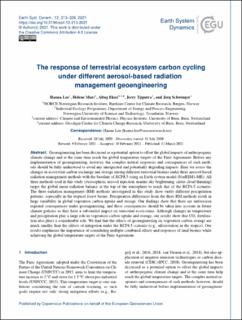| dc.contributor.author | Lee, Hanna | |
| dc.contributor.author | Muri, Helene | |
| dc.contributor.author | Ekici, Altug | |
| dc.contributor.author | Tjiputra, Jerry | |
| dc.contributor.author | Schwinger, Jörg | |
| dc.date.accessioned | 2021-09-20T07:34:43Z | |
| dc.date.available | 2021-09-20T07:34:43Z | |
| dc.date.created | 2020-08-11T11:19:01Z | |
| dc.date.issued | 2021 | |
| dc.identifier.citation | Earth System Dynamics. 2021, 12 (1), 313-326. | en_US |
| dc.identifier.issn | 2190-4979 | |
| dc.identifier.uri | https://hdl.handle.net/11250/2779063 | |
| dc.description.abstract | Geoengineering has been discussed as a potential option to offset the global impacts of anthropogenic climate change and at the same time reach the global temperature targets of the Paris Agreement. Before any implementation of geoengineering, however, the complex natural responses and consequences of such methods should be fully understood to avoid any unexpected and potentially degrading impacts. Here we assess the changes in ecosystem carbon exchange and storage among different terrestrial biomes under three aerosol-based radiation management methods with the baseline of RCP8.5 using an Earth system model (NorESM1-ME). All three methods used in this study (stratospheric aerosol injection, marine sky brightening, cirrus cloud thinning) target the global mean radiation balance at the top of the atmosphere to reach that of the RCP4.5 scenario. The three radiation management (RM) methods investigated in this study show vastly different precipitation patterns, especially in the tropical forest biome. Precipitation differences from the three RM methods result in large variability in global vegetation carbon uptake and storage. Our findings show that there are unforeseen regional consequences under geoengineering, and these consequences should be taken into account in future climate policies as they have a substantial impact on terrestrial ecosystems. Although changes in temperature and precipitation play a large role in vegetation carbon uptake and storage, our results show that CO2 fertilization also plays a considerable role. We find that the effects of geoengineering on vegetation carbon storage are much smaller than the effects of mitigation under the RCP4.5 scenario (e.g., afforestation in the tropics). Our results emphasize the importance of considering multiple combined effects and responses of land biomes while achieving the global temperature targets of the Paris Agreement. | en_US |
| dc.language.iso | eng | en_US |
| dc.publisher | European Geosciences Union | en_US |
| dc.rights | Navngivelse 4.0 Internasjonal | * |
| dc.rights.uri | http://creativecommons.org/licenses/by/4.0/deed.no | * |
| dc.title | The response of terrestrial ecosystem carbon cycling under different aerosol-based radiation management geoengineering | en_US |
| dc.type | Peer reviewed | en_US |
| dc.type | Journal article | en_US |
| dc.description.version | publishedVersion | en_US |
| dc.source.pagenumber | 313-326 | en_US |
| dc.source.volume | 12 | en_US |
| dc.source.journal | Earth System Dynamics | en_US |
| dc.source.issue | 1 | en_US |
| dc.identifier.doi | 10.5194/esd-12-313-2021 | |
| dc.identifier.cristin | 1822696 | |
| dc.relation.project | Notur/NorStore: nn9182k | en_US |
| dc.relation.project | Notur/NorStore: nn9448k | en_US |
| dc.relation.project | Norges forskningsråd: 229771 | en_US |
| dc.relation.project | Notur/NorStore: NS2345K | en_US |
| dc.relation.project | Norges forskningsråd: 229760 | en_US |
| dc.relation.project | Notur/NorStore: NS9033K | en_US |
| dc.relation.project | Norges forskningsråd: 268243 | en_US |
| dc.description.localcode | © Author(s) 2021. This work is distributed under the Creative Commons Attribution 4.0 License. | en_US |
| cristin.ispublished | true | |
| cristin.fulltext | original | |
| cristin.qualitycode | 1 | |

